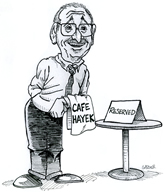… is from page 178 of Robert Higgs’s 2010 paper “Recession and Recovery: Six Fundamental Errors of the Current Orthodoxy,” as this paper is reprinted in Higg’s 2012 book Delusions of Power (original emphasis):
John Maynard Keynes persuaded his fellow economists and then they persuaded the public that it makes sense to think of the economy in terms of a handful of economywide aggregates: total income or output, total consumption spending, total investment spending, and total net exports. If people remember anything from their introductory economics course, they are most likely to remember the equation
Y = C + I + G + (X – M)
Sometimes Q⋅ P is equated to the variables on the right-hand side of the equation. So the idea is that aggregate supply (physical output Q times the price level P) equals aggregate demand equals the sum of four types of money expenditure for newly produced final goods and services – private consumption, private investment, government purchases, and net exports.
This way of compressing diverse, economywide transactions into single variables has the effect of suppressing recognition of the complex relationships and differences within each of the aggregates. Thus, in this framework, the effect of adding a million dollars of investment spending for teddy bear inventories is the same as the effect of adding a million dollars of investment spending for digging a new copper mine.
DBx: Yes.
Of course, all theorizing simplifies reality. It doesn’t follow, however, that all simplification of reality conduces to good theorizing. Keynesianism is a monument to unwise simplification – simplification that masks many essential features of the economy – simplification that results in a bad and misleading theory.
And excessive Keynesian-esque simplification haunts not only strictly macroeconomic theorizing of the sort that captured the bulk of Keynes’s attention. Such excessive simplification is evident in the pronouncements of nearly all protectionists. Many protectionists today, for example, demand policies to expand “the” manufacturing sector. They talk and write as if a policy is desirable if it results in manufacturing contributing a larger share of output to the economy. But almost never do these protectionists bother to ponder the details of their desire.
Treating manufacturing as a homogenous blob of economic activities, protectionists rarely ask what will happen to the existing pattern of manufacturing activities if government forces an expansion of overall manufacturing. The naive assumption is that all the manufacturing activities taking place on the day prior to the implementation of protective tariffs will continue in the days, months, and years afterwards without change as the tariffs simply multiply the number of manufacturing activities. Forget that protectionists never bother to ask if the expansion of manufacturing is worth the necessary contraction of service-sector activities; instead, note that protectionists never bother to ask if the details of manufacturing activities themselves might change for the worse if government forces an artificial expansion of manufacturing. The thought doesn’t even occur to them.



